lane assist VOLVO V60 2012 Owners Manual
[x] Cancel search | Manufacturer: VOLVO, Model Year: 2012, Model line: V60, Model: VOLVO V60 2012Pages: 400, PDF Size: 9.28 MB
Page 178 of 400
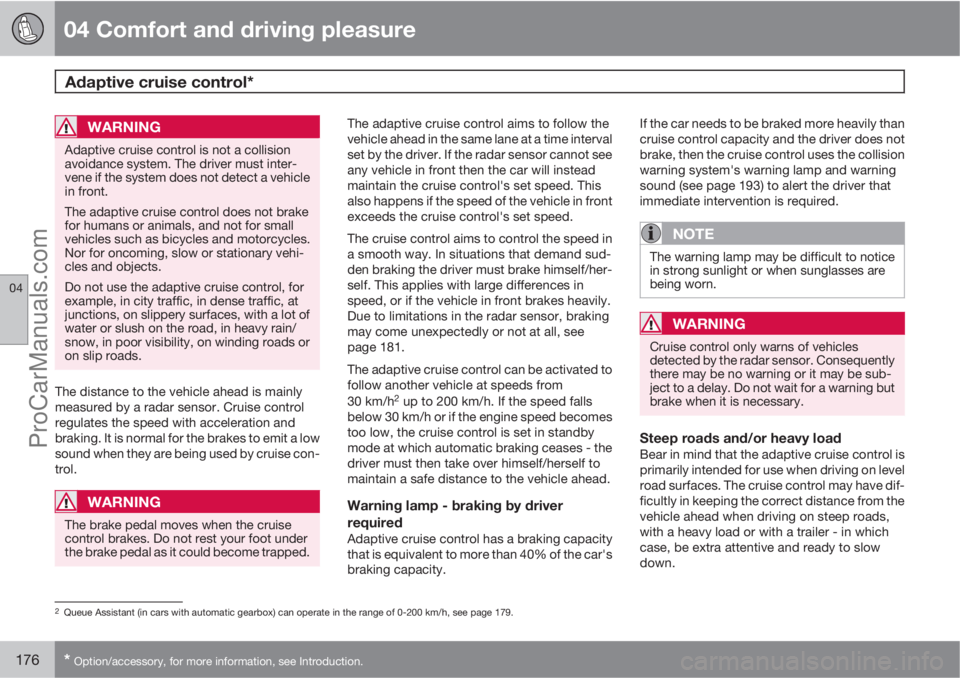
04 Comfort and driving pleasure
Adaptive cruise control*
04
176* Option/accessory, for more information, see Introduction.
WARNING
Adaptive cruise control is not a collision
avoidance system. The driver must inter-
vene if the system does not detect a vehicle
in front.
The adaptive cruise control does not brake
for humans or animals, and not for small
vehicles such as bicycles and motorcycles.
Nor for oncoming, slow or stationary vehi-
cles and objects.
Do not use the adaptive cruise control, for
example, in city traffic, in dense traffic, at
junctions, on slippery surfaces, with a lot of
water or slush on the road, in heavy rain/
snow, in poor visibility, on winding roads or
on slip roads.
The distance to the vehicle ahead is mainly
measured by a radar sensor. Cruise control
regulates the speed with acceleration and
braking. It is normal for the brakes to emit a low
sound when they are being used by cruise con-
trol.
WARNING
The brake pedal moves when the cruise
control brakes. Do not rest your foot under
the brake pedal as it could become trapped.
The adaptive cruise control aims to follow the
vehicle ahead in the same lane at a time interval
set by the driver. If the radar sensor cannot see
any vehicle in front then the car will instead
maintain the cruise control's set speed. This
also happens if the speed of the vehicle in front
exceeds the cruise control's set speed.
The cruise control aims to control the speed in
a smooth way. In situations that demand sud-
den braking the driver must brake himself/her-
self. This applies with large differences in
speed, or if the vehicle in front brakes heavily.
Due to limitations in the radar sensor, braking
may come unexpectedly or not at all, see
page 181.
The adaptive cruise control can be activated to
follow another vehicle at speeds from
30 km/h
2 up to 200 km/h. If the speed falls
below 30 km/h or if the engine speed becomes
too low, the cruise control is set in standby
mode at which automatic braking ceases - the
driver must then take over himself/herself to
maintain a safe distance to the vehicle ahead.
Warning lamp - braking by driver
required
Adaptive cruise control has a braking capacity
that is equivalent to more than 40% of the car's
braking capacity.If the car needs to be braked more heavily than
cruise control capacity and the driver does not
brake, then the cruise control uses the collision
warning system's warning lamp and warning
sound (see page 193) to alert the driver that
immediate intervention is required.
NOTE
The warning lamp may be difficult to notice
in strong sunlight or when sunglasses are
being worn.
WARNING
Cruise control only warns of vehicles
detected by the radar sensor. Consequently
there may be no warning or it may be sub-
ject to a delay. Do not wait for a warning but
brake when it is necessary.
Steep roads and/or heavy loadBear in mind that the adaptive cruise control is
primarily intended for use when driving on level
road surfaces. The cruise control may have dif-
ficultly in keeping the correct distance from the
vehicle ahead when driving on steep roads,
with a heavy load or with a trailer - in which
case, be extra attentive and ready to slow
down.
2Queue Assistant (in cars with automatic gearbox) can operate in the range of 0-200 km/h, see page 179.
ProCarManuals.com
Page 198 of 400
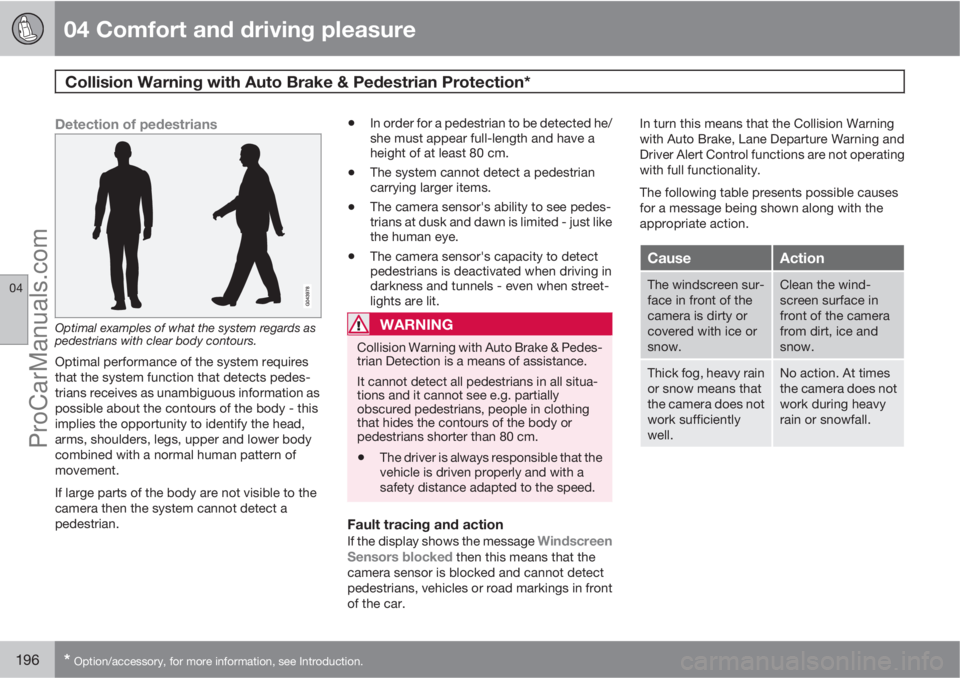
04 Comfort and driving pleasure
Collision Warning with Auto Brake & Pedestrian Protection*
04
196* Option/accessory, for more information, see Introduction.
Detection of pedestrians
Optimal examples of what the system regards as
pedestrians with clear body contours.
Optimal performance of the system requires
that the system function that detects pedes-
trians receives as unambiguous information as
possible about the contours of the body - this
implies the opportunity to identify the head,
arms, shoulders, legs, upper and lower body
combined with a normal human pattern of
movement.
If large parts of the body are not visible to the
camera then the system cannot detect a
pedestrian.
•In order for a pedestrian to be detected he/
she must appear full-length and have a
height of at least 80 cm.
•The system cannot detect a pedestrian
carrying larger items.
•The camera sensor's ability to see pedes-
trians at dusk and dawn is limited - just like
the human eye.
•The camera sensor's capacity to detect
pedestrians is deactivated when driving in
darkness and tunnels - even when street-
lights are lit.
WARNING
Collision Warning with Auto Brake & Pedes-
trian Detection is a means of assistance.
It cannot detect all pedestrians in all situa-
tions and it cannot see e.g. partially
obscured pedestrians, people in clothing
that hides the contours of the body or
pedestrians shorter than 80 cm.
•The driver is always responsible that the
vehicle is driven properly and with a
safety distance adapted to the speed.
Fault tracing and action
If the display shows the message Windscreen
Sensors blocked then this means that the
camera sensor is blocked and cannot detect
pedestrians, vehicles or road markings in front
of the car.In turn this means that the Collision Warning
with Auto Brake, Lane Departure Warning and
Driver Alert Control functions are not operating
with full functionality.
The following table presents possible causes
for a message being shown along with the
appropriate action.
CauseAction
The windscreen sur-
face in front of the
camera is dirty or
covered with ice or
snow.Clean the wind-
screen surface in
front of the camera
from dirt, ice and
snow.
Thick fog, heavy rain
or snow means that
the camera does not
work sufficiently
well.No action. At times
the camera does not
work during heavy
rain or snowfall.
ProCarManuals.com
Page 201 of 400
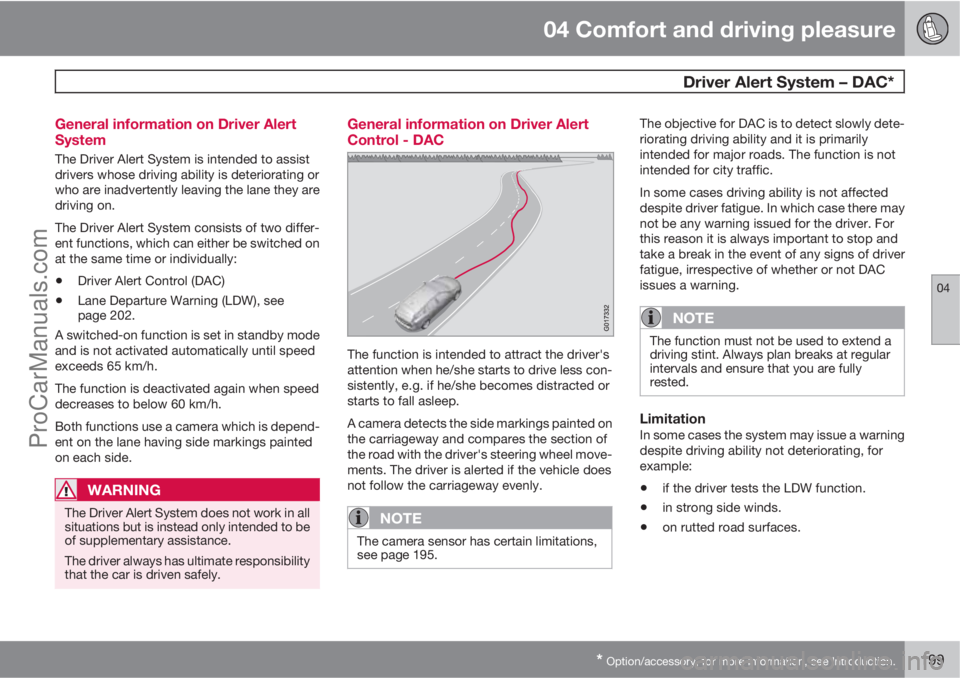
04 Comfort and driving pleasure
Driver Alert System – DAC*
04
* Option/accessory, for more information, see Introduction.199 General information on Driver Alert
System
The Driver Alert System is intended to assist
drivers whose driving ability is deteriorating or
who are inadvertently leaving the lane they are
driving on.
The Driver Alert System consists of two differ-
ent functions, which can either be switched on
at the same time or individually:
•Driver Alert Control (DAC)
•Lane Departure Warning (LDW), see
page 202.
A switched-on function is set in standby mode
and is not activated automatically until speed
exceeds 65 km/h.
The function is deactivated again when speed
decreases to below 60 km/h.
Both functions use a camera which is depend-
ent on the lane having side markings painted
on each side.
WARNING
The Driver Alert System does not work in all
situations but is instead only intended to be
of supplementary assistance.
The driver always has ultimate responsibility
that the car is driven safely.
General information on Driver Alert
Control - DAC
The function is intended to attract the driver's
attention when he/she starts to drive less con-
sistently, e.g. if he/she becomes distracted or
starts to fall asleep.
A camera detects the side markings painted on
the carriageway and compares the section of
the road with the driver's steering wheel move-
ments. The driver is alerted if the vehicle does
not follow the carriageway evenly.
NOTE
The camera sensor has certain limitations,
see page 195.
The objective for DAC is to detect slowly dete-
riorating driving ability and it is primarily
intended for major roads. The function is not
intended for city traffic.
In some cases driving ability is not affected
despite driver fatigue. In which case there may
not be any warning issued for the driver. For
this reason it is always important to stop and
take a break in the event of any signs of driver
fatigue, irrespective of whether or not DAC
issues a warning.
NOTE
The function must not be used to extend a
driving stint. Always plan breaks at regular
intervals and ensure that you are fully
rested.
LimitationIn some cases the system may issue a warning
despite driving ability not deteriorating, for
example:
•if the driver tests the LDW function.
•in strong side winds.
•on rutted road surfaces.
ProCarManuals.com
Page 212 of 400
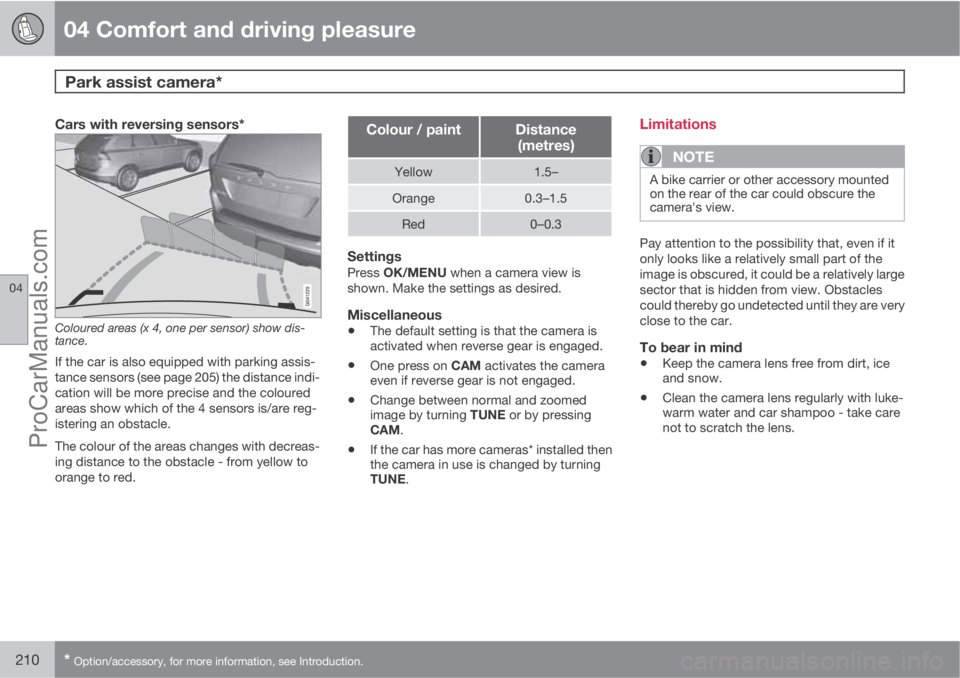
04 Comfort and driving pleasure
Park assist camera*
04
210* Option/accessory, for more information, see Introduction.
Cars with reversing sensors*
Coloured areas (x 4, one per sensor) show dis-
tance.
If the car is also equipped with parking assis-
tance sensors (see page 205) the distance indi-
cation will be more precise and the coloured
areas show which of the 4 sensors is/are reg-
istering an obstacle.
The colour of the areas changes with decreas-
ing distance to the obstacle - from yellow to
orange to red.
Colour / paintDistance
(metres)
Yellow1.5–
Orange0.3–1.5
Red0–0.3
SettingsPress OK/MENU when a camera view is
shown. Make the settings as desired.
Miscellaneous
•The default setting is that the camera is
activated when reverse gear is engaged.
•One press on CAM activates the camera
even if reverse gear is not engaged.
•Change between normal and zoomed
image by turning TUNE or by pressing
CAM.
•If the car has more cameras* installed then
the camera in use is changed by turning
TUNE.
Limitations
NOTE
A bike carrier or other accessory mounted
on the rear of the car could obscure the
camera's view.
Pay attention to the possibility that, even if it
only looks like a relatively small part of the
image is obscured, it could be a relatively large
sector that is hidden from view. Obstacles
could thereby go undetected until they are very
close to the car.
To bear in mind
•Keep the camera lens free from dirt, ice
and snow.
•Clean the camera lens regularly with luke-
warm water and car shampoo - take care
not to scratch the lens.
ProCarManuals.com
Page 290 of 400
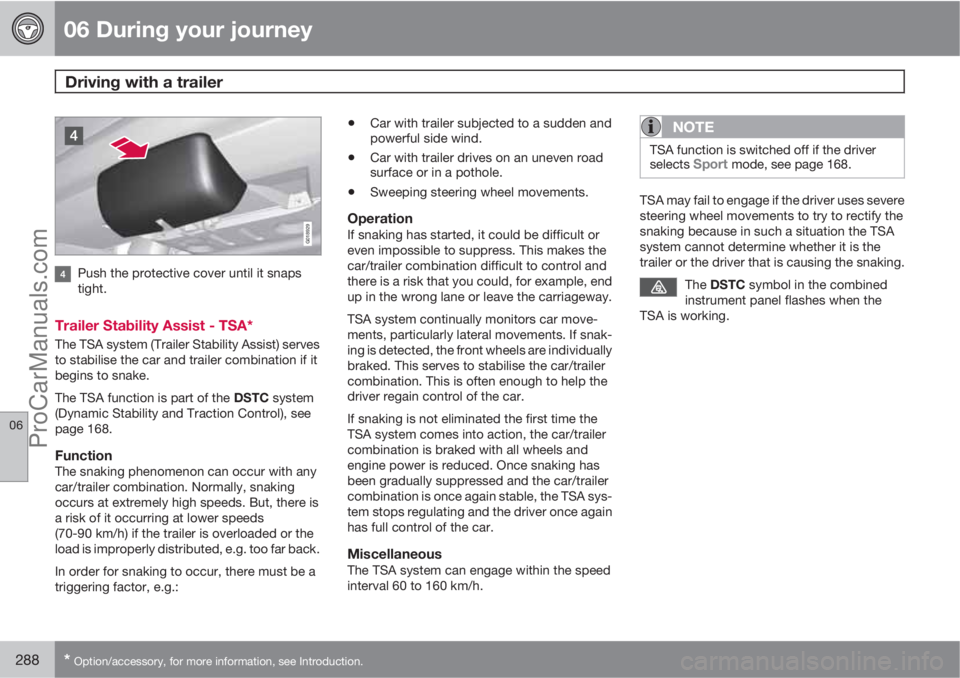
06 During your journey
Driving with a trailer
06
288* Option/accessory, for more information, see Introduction.
G018929
Push the protective cover until it snaps
tight.
Trailer Stability Assist - TSA*
The TSA system (Trailer Stability Assist) serves
to stabilise the car and trailer combination if it
begins to snake.
The TSA function is part of the DSTC system
(Dynamic Stability and Traction Control), see
page 168.
FunctionThe snaking phenomenon can occur with any
car/trailer combination. Normally, snaking
occurs at extremely high speeds. But, there is
a risk of it occurring at lower speeds
(70-90 km/h) if the trailer is overloaded or the
load is improperly distributed, e.g. too far back.
In order for snaking to occur, there must be a
triggering factor, e.g.:
•Car with trailer subjected to a sudden and
powerful side wind.
•Car with trailer drives on an uneven road
surface or in a pothole.
•Sweeping steering wheel movements.
OperationIf snaking has started, it could be difficult or
even impossible to suppress. This makes the
car/trailer combination difficult to control and
there is a risk that you could, for example, end
up in the wrong lane or leave the carriageway.
TSA system continually monitors car move-
ments, particularly lateral movements. If snak-
ing is detected, the front wheels are individually
braked. This serves to stabilise the car/trailer
combination. This is often enough to help the
driver regain control of the car.
If snaking is not eliminated the first time the
TSA system comes into action, the car/trailer
combination is braked with all wheels and
engine power is reduced. Once snaking has
been gradually suppressed and the car/trailer
combination is once again stable, the TSA sys-
tem stops regulating and the driver once again
has full control of the car.
MiscellaneousThe TSA system can engage within the speed
interval 60 to 160 km/h.
NOTE
TSA function is switched off if the driver
selects Sport mode, see page 168.
TSA may fail to engage if the driver uses severe
steering wheel movements to try to rectify the
snaking because in such a situation the TSA
system cannot determine whether it is the
trailer or the driver that is causing the snaking.
The DSTC symbol in the combined
instrument panel flashes when the
TSA is working.
ProCarManuals.com
Page 393 of 400
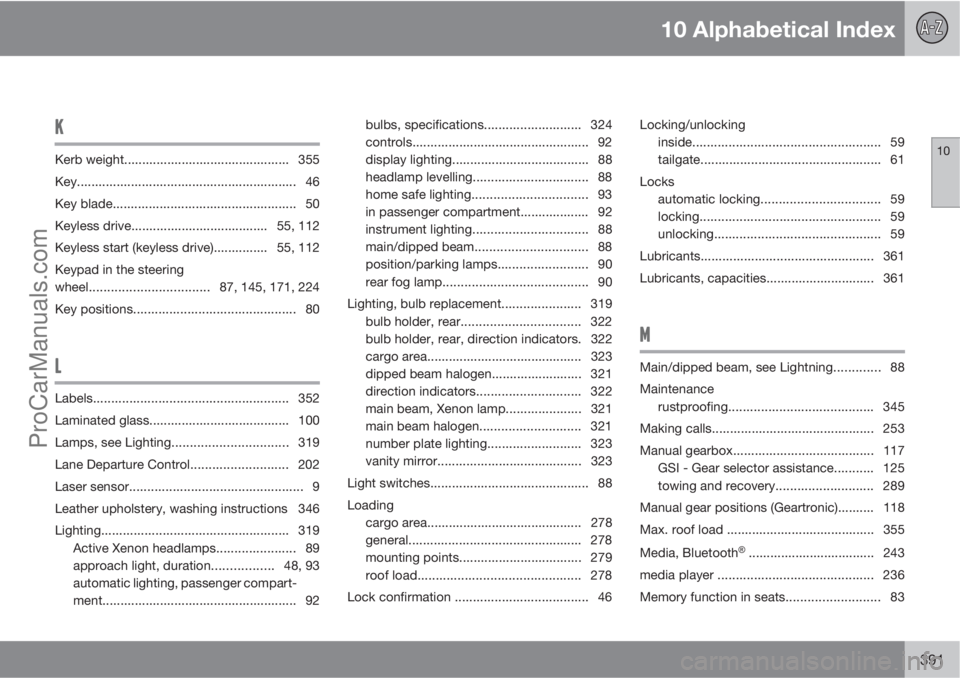
10 Alphabetical Index
10
391
K
Kerb weight.............................................. 355
Key............................................................. 46
Key blade................................................... 50
Keyless drive...................................... 55, 112
Keyless start (keyless drive)............... 55, 112
Keypad in the steering
wheel.................................87, 145, 171, 224
Key positions............................................. 80
L
Labels...................................................... 352
Laminated glass....................................... 100
Lamps, see Lighting................................319
Lane Departure Control........................... 202
Laser sensor................................................ 9
Leather upholstery, washing instructions 346
Lighting.................................................... 319
Active Xenon headlamps...................... 89
approach light, duration.................48, 93
automatic lighting, passenger compart-
ment...................................................... 92bulbs, specifications........................... 324
controls................................................. 92
display lighting...................................... 88
headlamp levelling................................ 88
home safe lighting................................ 93
in passenger compartment................... 92
instrument lighting................................ 88
main/dipped beam............................... 88
position/parking lamps......................... 90
rear fog lamp........................................ 90
Lighting, bulb replacement...................... 319
bulb holder, rear................................. 322
bulb holder, rear, direction indicators. 322
cargo area........................................... 323
dipped beam halogen......................... 321
direction indicators............................. 322
main beam, Xenon lamp.....................321
main beam halogen............................ 321
number plate lighting.......................... 323
vanity mirror........................................ 323
Light switches............................................ 88
Loading
cargo area........................................... 278
general................................................ 278
mounting points.................................. 279
roof load............................................. 278
Lock confirmation ..................................... 46Locking/unlocking
inside.................................................... 59
tailgate.................................................. 61
Locks
automatic locking................................. 59
locking.................................................. 59
unlocking.............................................. 59
Lubricants................................................ 361
Lubricants, capacities.............................. 361
M
Main/dipped beam, see Lightning............. 88
Maintenance
rustproofing........................................ 345
Making calls............................................. 253
Manual gearbox....................................... 117
GSI - Gear selector assistance........... 125
towing and recovery........................... 289
Manual gear positions (Geartronic).......... 118
Max. roof load ......................................... 355
Media, Bluetooth
�Ÿ ................................... 243
media player ........................................... 236
Memory function in seats.......................... 83
ProCarManuals.com
Page 394 of 400
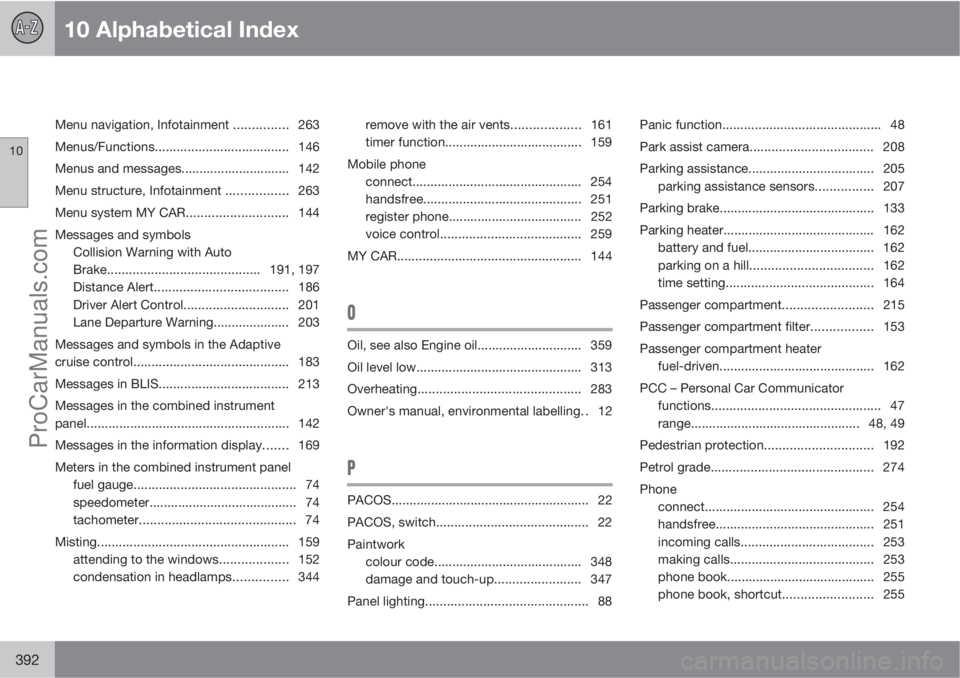
10 Alphabetical Index
10
392
Menu navigation, Infotainment ............... 263
Menus/Functions..................................... 146
Menus and messages.............................. 142
Menu structure, Infotainment ................. 263
Menu system MY CAR............................144
Messages and symbols
Collision Warning with Auto
Brake..........................................191, 197
Distance Alert..................................... 186
Driver Alert Control............................. 201
Lane Departure Warning..................... 203
Messages and symbols in the Adaptive
cruise control........................................... 183
Messages in BLIS.................................... 213
Messages in the combined instrument
panel........................................................142
Messages in the information display....... 169
Meters in the combined instrument panel
fuel gauge............................................. 74
speedometer......................................... 74
tachometer........................................... 74
Misting..................................................... 159
attending to the windows...................152
condensation in headlamps............... 344remove with the air vents................... 161
timer function...................................... 159
Mobile phone
connect............................................... 254
handsfree............................................ 251
register phone..................................... 252
voice control....................................... 259
MY CAR................................................... 144
O
Oil, see also Engine oil............................. 359
Oil level low.............................................. 313
Overheating............................................. 283
Owner's manual, environmental labelling. . 12
P
PACOS....................................................... 22
PACOS, switch.......................................... 22
Paintwork
colour code......................................... 348
damage and touch-up........................ 347
Panel lighting............................................. 88Panic function............................................ 48
Park assist camera.................................. 208
Parking assistance................................... 205
parking assistance sensors................ 207
Parking brake........................................... 133
Parking heater.......................................... 162
battery and fuel................................... 162
parking on a hill..................................162
time setting......................................... 164
Passenger compartment.........................215
Passenger compartment filter................. 153
Passenger compartment heater
fuel-driven........................................... 162
PCC – Personal Car Communicator
functions............................................... 47
range............................................... 48, 49
Pedestrian protection..............................192
Petrol grade............................................. 274
Phone
connect............................................... 254
handsfree............................................ 251
incoming calls..................................... 253
making calls........................................ 253
phone book......................................... 255
phone book, shortcut.........................255
ProCarManuals.com
Page 396 of 400
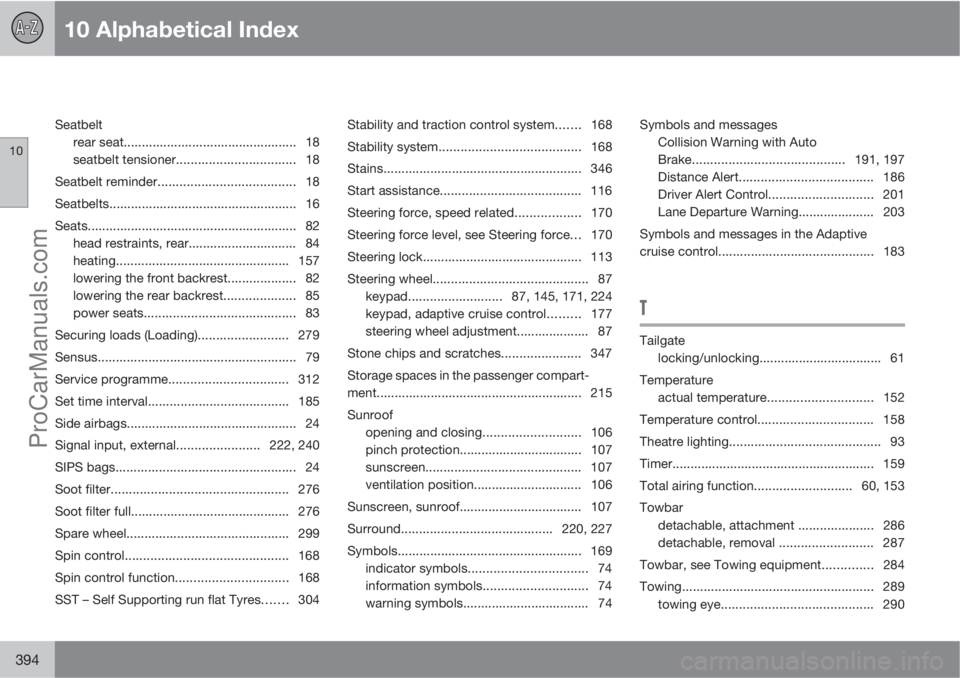
10 Alphabetical Index
10
394
Seatbelt
rear seat................................................ 18
seatbelt tensioner................................. 18
Seatbelt reminder...................................... 18
Seatbelts.................................................... 16
Seats.......................................................... 82
head restraints, rear.............................. 84
heating................................................ 157
lowering the front backrest................... 82
lowering the rear backrest.................... 85
power seats.......................................... 83
Securing loads (Loading)......................... 279
Sensus....................................................... 79
Service programme................................. 312
Set time interval....................................... 185
Side airbags............................................... 24
Signal input, external.......................222, 240
SIPS bags.................................................. 24
Soot filter................................................. 276
Soot filter full............................................ 276
Spare wheel............................................. 299
Spin control............................................. 168
Spin control function...............................168
SST – Self Supporting run flat Tyres....... 304Stability and traction control system....... 168
Stability system....................................... 168
Stains....................................................... 346
Start assistance....................................... 116
Steering force, speed related.................. 170
Steering force level, see Steering force... 170
Steering lock............................................ 113
Steering wheel........................................... 87
keypad.......................... 87, 145, 171, 224
keypad, adaptive cruise control......... 177
steering wheel adjustment.................... 87
Stone chips and scratches...................... 347
Storage spaces in the passenger compart-
ment......................................................... 215
Sunroof
opening and closing...........................106
pinch protection.................................. 107
sunscreen........................................... 107
ventilation position.............................. 106
Sunscreen, sunroof.................................. 107
Surround.......................................... 220, 227
Symbols................................................... 169
indicator symbols................................. 74
information symbols............................. 74
warning symbols................................... 74Symbols and messages
Collision Warning with Auto
Brake..........................................191, 197
Distance Alert..................................... 186
Driver Alert Control............................. 201
Lane Departure Warning..................... 203
Symbols and messages in the Adaptive
cruise control........................................... 183
T
Tailgate
locking/unlocking.................................. 61
Temperature
actual temperature.............................152
Temperature control................................ 158
Theatre lighting.......................................... 93
Timer........................................................ 159
Total airing function...........................60, 153
Towbar
detachable, attachment ..................... 286
detachable, removal .......................... 287
Towbar, see Towing equipment.............. 284
Towing..................................................... 289
towing eye.......................................... 290
ProCarManuals.com